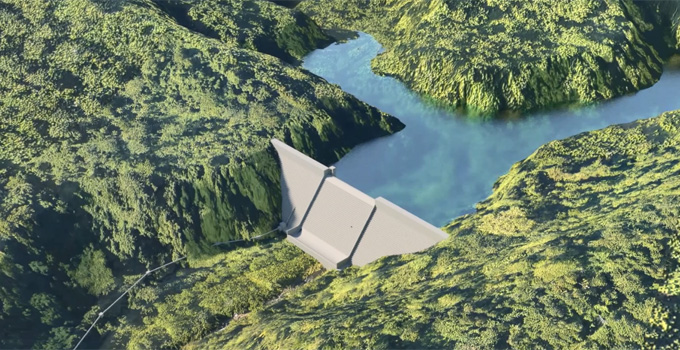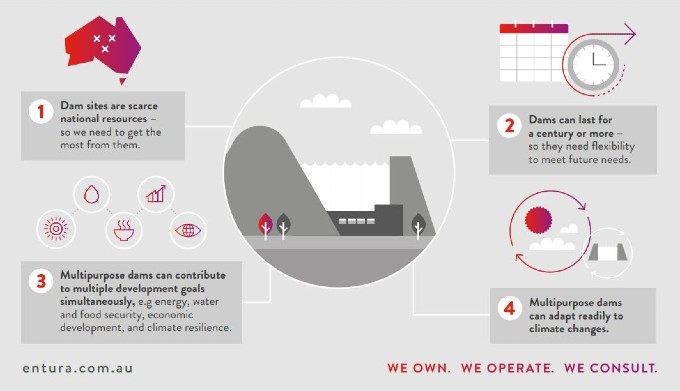THOUGHT LEADERSHIP
Multipurpose dams: maximum value for money?
When a dam is being considered, there’s usually a primary purpose. But are there also secondary purposes that can benefit the local and wider community? Have you thought about the potential additional economic development that can stem from a multipurpose dam?
Multipurpose dams combine two or more functions of traditional single-purpose dams into one dam infrastructure project. A multipurpose dam may combine storing and supplying water for irrigation, industry or human consumption; flood control; power generation and power storage; navigation; water regulation; environmental releases; climate change resilience; and recreational purposes.
The dam structure will be similar to a single-purpose dam, but the design will incorporate features into the dam and water infrastructure facility to accommodate different purposes. These may take the form of irrigation channels, power generation facilities or navigation facilities. Including various gates or valves can provide greater operational flexibility for floods or environmental releases for downstream community and environmental needs. A single-purpose project can become multipurpose during its planning stage, during operation, or in the long term when re-engineering becomes necessary.
Why consider multiple purposes?
Multipurpose dams are not a new concept; in fact, almost half of all dams are used for more than one purpose. There is a growing trend to consider multiple purposes when developing a dam, for several reasons:
- Dam sites, particularly storage sites, are scarce national resources (i.e. they are not unlimited), so it makes sense to consider how to extract maximum benefit from them when constructed.
- Dam infrastructure may commonly last for up to 100 years or more (i.e. they are considered a long-term asset). A dam represents a genuine long-term investment for the future, and so ideally should be viewed as such and incorporate the potential for flexible use over time.
- Multipurpose dams are very beneficial in developing countries, as the multi-functionality of the dam operations can contribute to a number of development goals simultaneously, such as energy, water and food security, economic development, and climate resilience. In 2016, the International Commission of Large Dams (ICOLD) recognised the importance of multipurpose dams in the release of the ICOLD Bulletin ‘Multipurpose Water Storage – Essential Elements and Emerging Trends’, which rightly links the common global needs of water, food and energy. The sporadic, spatial and temporal distribution of precipitation rarely coincides with demand, making storage essential for food supply, energy production, potable water supply and other water delivery services that depend on sizable, reliable, continuous and efficient supply of water.
- Climate change scenarios predict increasing variability in rainfall, impacting both yields and flood peaks. Droughts will affect agricultural production, and flooding is expected to increase due to more extreme weather events. With many regions of the world experiencing significant water stress, which is expected to be exacerbated by global warming, storage will play an increasingly critical role in bolstering a water system’s hydrological resilience. Dam projects should be designed with this necessity and value of storage in mind. Even in developed countries, we need our dam infrastructure to be ready to adapt to future changes as required. Taking change into account and considering multipurpose approaches will benefit new dam projects as well as projects that modify existing reservoirs.
Looking into the future
Multipurpose water storage projects pose additional engineering challenges when compared to single-purpose projects. Given the longevity of the infrastructure of large storage projects, planning professionals need to develop and implement solutions that will provide adequate flexibility to adapt to changes or to the diverse needs of multipurpose schemes. Scale, site selection and operational characteristics should be assessed through a long-term perspective, incorporating anticipated trends and emphasising adaptability so that future generations will inherit infrastructure that can evolve as the world continues to change.
There is no doubt that this sustainability principle is valid; however, determining how best to implement it in practice is not always easy. It is hard to anticipate and predict what will happen in a century (which is the expected life of many dams), yet this should not stop us during the early stages of the project from trying to assess long-term performance based on potential long-term scenarios (i.e. scenario testing).
Multiple perspectives for multiple purposes
Achieving the best outcome for a multipurpose dam is more likely when planners and engineers work together and closely consider the local community’s needs and the potential benefits to be gained. Both social and environmental needs should be considered, with detailed social and environmental impact assessments conducted.
Applying the principles of Integrated Water Resource Management (IWRM) in the planning process will help promote coordinated development and optimal management of water resources – furthering progress towards goals of social equity, economic efficiency and environmental sustainability. It is important to establish criteria by which to monitor the achievement of the multipurpose objectives and the post-construction impacts on the community and environment. Another important consideration is the manner of operation of the multipurpose reservoir, which will also be critical to achieving the range of its objectives.
What is a multipurpose dam worth?
A key planning challenge in multipurpose dam infrastructure is fully appraising the economic costs and benefits of the project. In many projects there’s a tendency to focus the analysis on the components that provide revenue streams (such as energy and water supply and irrigation tariffs) as these are most easily valued. However, this can underrepresent the project’s value across all of its multipurpose objectives, potentially resulting in suboptimal decision making or difficulty justifying the long-term investment. For example, a fundamental purpose of storage projects is flood mitigation – but flood mitigation does not generate a revenue stream. However, the economic value of flood control to a country (through avoidance of direct and indirect flood damages) often justifies the allocation of funds from the public sector.
Putting this into practice in Samoa
The Alaoa Multi-Purpose Dam in Samoa is a fitting example of the considerations presented above.
Samoa is a small tropical island country in the Pacific, and has been heavily affected by severe tropical storms. In 2012, Cyclone Evan caused extensive flooding and damage to the Apia region, the capital, where most of the population and economic activity is located. With such storms predicted to increase in frequency and severity as the climate changes, the Government of Samoa has adopted a programmatic approach to address climate-change-induced flooding. This includes the new Alaoa Multi-Purpose Dam, sized and designed with long-term climate scenarios in mind and to provide multiple functions. It aims to increase flood protection, improve the current water supply system’s seasonal reliability, and provide additional hydropower via installation of a small hydro facility.
The dam’s design considered multipurpose functions and climate change risks, and included small modifications to provide better outcomes. Climate resilience was ‘designed in’ by incorporating ‘dead storage’, providing sediment flushing capability, increasing the flood capacity, and including a number of gates and valves – all contributing to future flexibility of operation.
The intake to the small hydro station incorporated a station bypass valve for water supply. As well, a low-level outlet and a mid-level outlet were added to increase the operational flexibility of the dam to meet its three purposes. This also enabled both low-flow and high-flow environmental releases, and improved dam safety management. How the reservoir is operated will be significant in achieving the multipurpose functions. The dam’s flexibility will allow future adaptive modification of the operation to align with the changing demands of the reservoir.
The main purpose of the Alaoa Multi-Purpose Dam was flood retention and mitigation. Consequently, as we discussed above, a limited financial analysis could not justify the multipurpose project, yet the broader economic analysis could. However, the financial analysis indicated that the regular revenue stream from the small hydro’s energy production could increase the project’s sustainability once constructed. This revenue stream would contribute to the ongoing operation, maintenance and dam safety activities associated with the multipurpose project’s long-term operation.
Could multiple purposes be incorporated into your dam project?
Whether you are in the planning process or the early design phase for a new dam, consider whether your project could be modified to:
- achieve multiple purposes and increase the benefits of your dam project
- increase operational flexibility to allow your dam to adapt to future changes and demands
- improve the use of water resources for all needs, including the environment
- increase the climate resilience of your dam and the impact of climate change on its multiple objectives.
If you would like to discuss how we can assist you with planning and designing a multipurpose dam, please contact Richard Herweynen, Paul Southcott or Phillip Ellerton.
About the author
Richard Herweynen is Entura’s Technical Director, Water. Richard has three decades of experience in dam and hydropower engineering, and has worked throughout the Indo-Pacific region on both dam and hydropower projects, covering all aspects including investigations, feasibility studies, detailed design, construction liaison, operation and maintenance and risk assessment for both new and existing projects. Richard has been part of a number of recent expert review panels for major water projects. He participated in the ANCOLD working group for concrete gravity dams and is the Chairman of the ICOLD technical committee on engineering activities in the planning process for water resources projects. Richard has won many engineering excellence and innovation awards (including Engineers Australia’s Professional Engineer of the Year 2012 – Tasmanian Division), and has published more than 30 technical papers on dam engineering.
MORE THOUGHT LEADERSHIP ARTICLES
23 February, 2021








